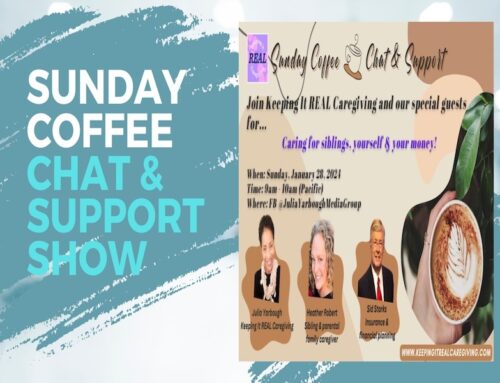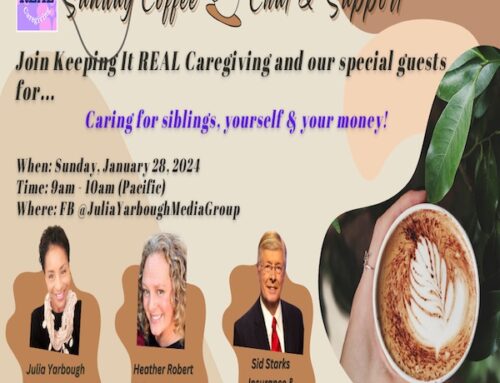Can tech offer more solutions for eldercare?

Have you SUBSCRIBED to the Keeping it REAL Caregiving Newsletter? Be sure to sign up so you don’t miss any updates! You can also find us on Facebook, Twitter and Instagram. Be sure to visit the Keeping it REAL Caregiving website for video stories, podcasts and upcoming events!
Does the following describe you?
You do anything and everything required for the care of your loved one; both physically and emotionally.
There is a part of you that wants to ask for help, but you don’t quite trust anyone else to do things ‘correctly.’
You also feel the need to set up social interactions and entertainment for your loved one. After all, you are increasingly aware of how harmful social isolation can be for elders.

Girls’ lunch out – Northern California 2016 – Nellie; Julia Yarbough & friends
Secretaries could learn from YOU based on how well you make and keep appointments for doctors’ visits and prescription pick-ups.
Sound familiar? This was my life in the final years of caring for Miss Nellie. No matter how organized, I always felt like I was chasing my tail with never enough time or resources.
The good news is caregivers and their elders are increasingly finding some relief – through technology.
Tech connections & CHAT
If there is any good which has come from the coronavirus pandemic, it is that it has put a spotlight on current care-systems, and the needs and challenges faced by many older adults and/or caregivers. Even now, the Covid landscape is evolving.
KIRC reached out to Joe Cobery, the Director of Passages. That is the Area Agency on Aging provider for Butte, Tehama, Plumas, Glenn and Colusa counties in Northern California. We talked about how technology is increasingly being incorporated into care-solutions.
“The pandemic provided insight as to how vulnerable our elders were. They were most at risk for catching the virus, had the highest rates of hospitalizations and the highest death rates.”
Cobery says those realizations have motivated increased legislative attention and action, to the needs of elders.
As part of funding through the CARES Act, and guidance through California’s Master Plan for Aging, the state has developed what is known as the Connections, Health, Aging and Technology (CHAT) project.
It is part of a larger effort to improve connectivity across the state.
An August 2020 Executive order by California’s governor called for improving broadband speed and access for two million people across the state, with older adults as a priority.
The goal of CHAT is to try and further bridge that digital divide. For this project, that means getting 4-thousand iPads (with data plans and technical support), and over 85-hundred Google Homes Smart Speakers (donated to the state by Google) into the homes and hands of elders across the state.
A California Department of Aging Memo outlining the program and its goals reads,
‘…the purpose of this project is to mitigate loneliness and isolation for older adults providing them with greater access to resources and information.’

Courtesy: Joe Cobery/Passages
Right now, Passages is in the pilot stage of the program, so the devices are not yet in homes or being used.
Cobery confirms the agency has received 20 iPads and a number of the Google voice devices for distribution across the five county service area.
Cobery says Passages is in the process of identifying eligible clients and then figuring out how to get those folks properly trained to be able to use the devices.
He explains that offering in-home and hands-on training is still a safety-risk due to Covid-19.

Courtesy: Joe Cobery/Passages
“Many older adults 80-plus haven’t been exposed to technology. So when we talk about bridging the digital divide, it is also about education in addition to the devices. We have to think about interfaces that are going to be suitable for older adults, such as large screens or buttons they can touch and a system they can hear. It goes beyond just having a device.”
How can this help me?
Okay, so you’re probably asking, how is having an iPad going to help? For the daily hands-on work of caring for an elder including transfers, bathing, toileting, etc., … let’s face it – those of us who have lived the caregiving role know a tablet or voice device is unable to do our work.
But, here’s how adding technology into the mix can assist, and why it is at least a start. Consider the following uses:
Making appointments via voice activation could potentially free up a bit of extra time for a caregiver
An elder could interact with others for chats, gaming, church services, movies, etc. via their tablet. That elder no longer feels so alone and isolated; a caregiver can focus on other tasks
Prescriptions, groceries and other needed items could be ordered online (maybe even using voice commands) and/or delivered, reducing or eliminating the need for time-consuming errands
“So many things have gone the way of higher-end technology,” says Cobery. “If you want to sign up for Medicare, you can do that online. Health insurance is online. Bridging the digital divide is crucial because we have to have our older folks able to access various programs.”
Cobery says elders should not be excluded simply because they don’t have the equipment or the skills. He believes increased technology could also lead to more individuals being able to age in place and remain in their homes.
**KIRC wants to hear from you! Are you someone who is using technology in a creative way to enhance your elder’s life or ease the work of caregiving? Share your experiences – jump into the conversation! ***
Learning from others
During a recent webinar, KIRC learned of an agency on the other side of the country, which has already implemented the use of tablets for elders.
What can California aging leaders learn from their experiences? Those are some of the questions KIRC is asking.
Be sure to check out the next update from the Keeping it REAL Caregiving newsletter to see and hear how that program works and how it is making a positive difference.
Until next time~

Ciao!





Like our content? We invite you to leave a comment and say hello!